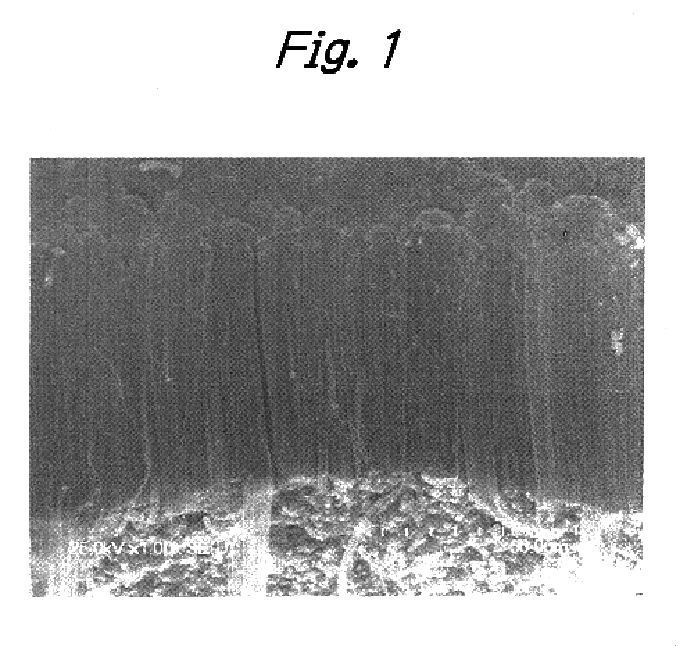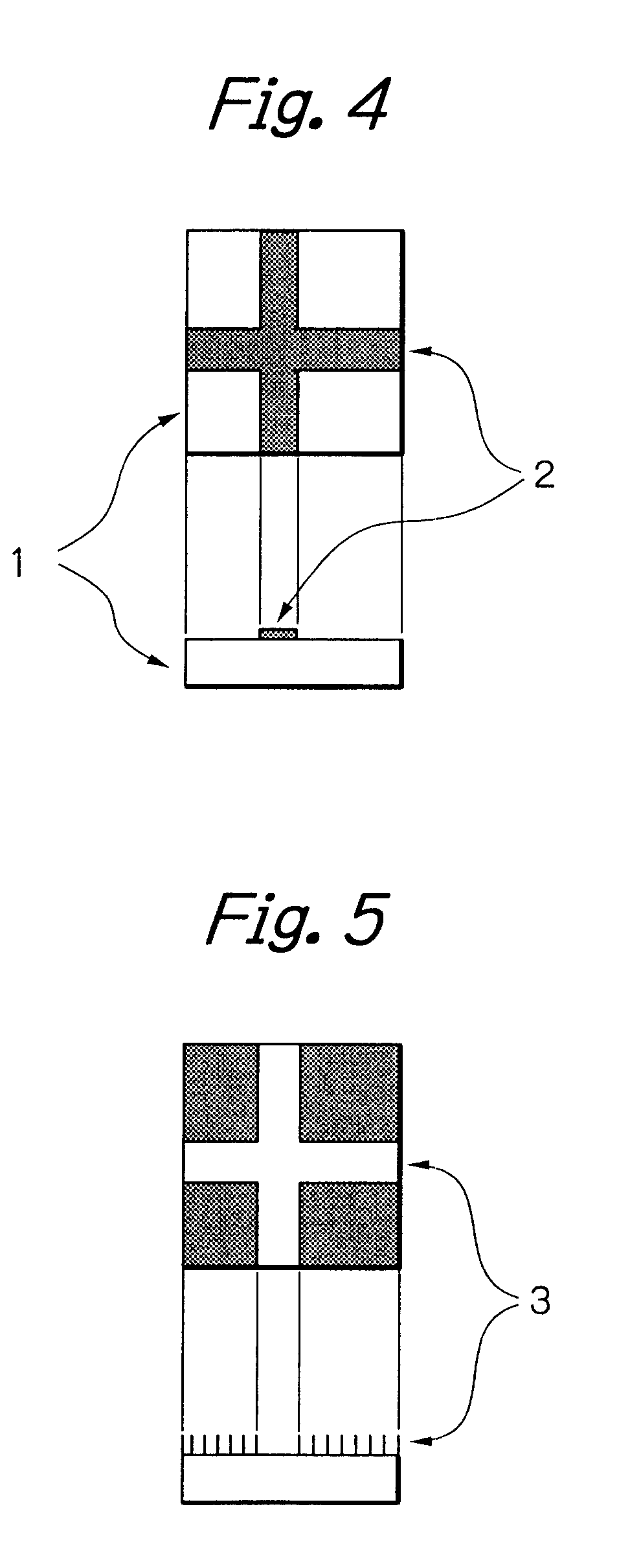Process for producing aligned carbon nanotube films
a carbon nanotube and film technology, applied in the direction of catalyst activation/preparation, physical/chemical process catalysts, metal/metal-oxide/metal-hydroxide catalysts, etc., can solve the problems of difficult to realize inexpensive production of large-area, aligned carbon nanotube films that are suitable, and the obtained nanotubes
- Summary
- Abstract
- Description
- Claims
- Application Information
AI Technical Summary
Benefits of technology
Problems solved by technology
Method used
Image
Examples
example 1
[0036]A square silica-alumina substrate consisting of 25% silica and 75% alumina and measuring 2 mm thick and 75 mm on each side was deposited with aluminum by vacuum deposition. The deposited aluminum film was 0.5 μm thick. The substrate was then dipped for 2 hours in an aqueous solution of cobalt nitrate at a concentration of 0.2 mol / L. The substrate was recovered from the aqueous solution and calcined in air at 400° C. for 3 hours. After the calcining, the substrate was placed horizontally in a tubular quartz glass furnace (diameter is 35 mm) with the aluminum-deposited side facing up. The tubular furnace was heated up to 700° C. with argon being blown horizontally at a flow rate of 1000 cm3 / min under atmospheric pressure (0.1 MPa). Subsequently, with the temperature of 700° C. being kept, a mixture of propylene (300 cm3 / min) and argon (1000 cm3 / min) was blown into the tubular furnace. After flowing of the propylene / argon mixed gas for 20 minutes, the gas supply was switched to a...
example 2
[0038]A square alumina substrate measuring 2 mm thick and 75 mm on each side was deposited with aluminum by vacuum deposition. The deposited aluminum film was 0.7 μm thick. In the next step, there was prepared a mixed solution containing cobalt nitrate and nickel nitrate each at a concentration of 0.1 mol / L; an aqueous solution of sodium hydrogencarbonate (0.4 mol / L) was added to the mixed solution and the mixture was stirred for 30 minutes. Thereafter, the mixture was decanted and the resulting sol was applied with a brush onto the aluminum deposited side of the substrate. The substrate was then dried at 100° C. for 30 minutes. The same procedure of coating and drying operations was repeated twice before the substrate was calcined in air at 400° C. for 3 hours. After the calcining, the substrate was placed horizontally in a tubular quartz glass furnace (diameter is 35 mm) with the aluminum deposited side facing up. The tubular furnace was heated up to 700° C. with argon being blown...
example 3
[0040]A square silica-alumina substrate measuring 2 mm thick and 30 mm on each side was heated in air at 400° C. for 3 hours and then deposited with aluminum by vacuum deposition. The deposited aluminum film was 0.2 μm thick.
[0041]An aqueous solution of cobalt nitrate (0.3 mol / L) was cooled to 10° C. and to the stirred solution, 0.2 ml of 29% aqueous ammonia was added. Blue cobalt hydroxide particles were generated in the purple aqueous solution to form a suspension. After stirring the suspension for 10 minutes, the previously prepared aluminum-deposited substrate was dipped in the stirred suspension for 10 minutes.
[0042]The substrate was recovered from the suspension and calcined in air at 400° C. for 3 hours.
[0043]After the calcining, the substrate was placed horizontally in a tubular quartz glass furnace (diameter is 35 mm) with the aluminum-deposited side facing up. The tubular furnace was heated up to 700° C. with argon being blown horizontally at a flow rate of 360 cm3 / min und...
PUM
| Property | Measurement | Unit |
|---|---|---|
| size | aaaaa | aaaaa |
| temperature | aaaaa | aaaaa |
| temperature | aaaaa | aaaaa |
Abstract
Description
Claims
Application Information
 Login to View More
Login to View More - R&D
- Intellectual Property
- Life Sciences
- Materials
- Tech Scout
- Unparalleled Data Quality
- Higher Quality Content
- 60% Fewer Hallucinations
Browse by: Latest US Patents, China's latest patents, Technical Efficacy Thesaurus, Application Domain, Technology Topic, Popular Technical Reports.
© 2025 PatSnap. All rights reserved.Legal|Privacy policy|Modern Slavery Act Transparency Statement|Sitemap|About US| Contact US: help@patsnap.com



